Sending this to Yeastspotting.

This is the theme for this month's Daring Bakers' Challenge. One look at the original recipe (see here), I knew it wouldn't produce the croissants I want. Don't get me wrong, I worship Julia Child, but I think she made some compromises here so that it's less daunting for the home bakers, however, the quality suffers as the result. All the changes I made were based on the lessons I learned over the last few months of croissant marathon, you may find that they correspond closely to the tips I gave in this original croissant post.
1. Reduced the water amount by A LOT
2. Reduced the oil amount by A LOT. The original recipe yields incredibly wet doughs, while it's easier to roll out, it affects crumb negatively. The first 2 changes mean to make the dough drier, and crumb more crisp. Note that this recipe uses oil rather than butter in the dough, which makes the dough more extensible(i.e. easier to roll out). It would make the dough stronger if I replace it with butter, but I kept oil to stay somewhat true to the original recipe - I can get the dough strength in other ways.
3. Reduced salt. The original recipe yields VERY salty croissants.
4. The original recipe soften the roll-in butter then "smear" it onto the rolled out dough. It may see easier than making a butter block then enclose it, but softened butter is warmer butter, which means it's easier to melt, a big NO NO if you want clear flaky layers. In addition, smearing doesn't produce even butter layers either. I still used my usual method to enclose butter: make a butter block, fridge, enclose into dough. (picture below with recipe)
5. Used bread flour rather than AP flour.
6. Kneaded the dough much longer than what the recipe required. Both 5 and 6 aim to increase dough strength. Stronger dough rises higher during baking, creating clear layers and open honeycomb crumb. Yes, stronger dough is also harder to roll out, but it's worthwhile.
7. The original recipes requires 4 bookfolds, which IMO, is way too much for such small croissants (much smaller than the standard size I made before). More folds == more layers, good in theory, easy to have leaky butter in practice. Even if the butter doesn't leak, more layers in such a small roll would just make the crumb less "open". I only made 3 bookfolds as usual.
8. The original recipe doesn't produce a lot of dough, yet still makes 12 croissants, so each one is tiny-mini. On top of that, the shaping process has unusal sizes (bottom and sides are of the same length for each triangle, which means each croissant is very long, but doesn't have a lot of layers), and too much stretching (easy to melt the butter). I changed the sizes to make 8 croissants (still much smaller than standard size, but at least each croissant is rolled up enough times to create a layered crumb).
9. Extended proofing time from 1.5 hr to 3.5 hr. Croissants MUST be fully proofed for a good crumb.
Note: this recipe requires a builk rise , which is different from all the other croissant recipes I tried before. Bulk rise made the dough extra strong - again, harder to roll out, but crumb is better.
Croissants (majorly adapted from Julia Child)
Note: Makes 8 small croissants
Note: for details and tips, please see this post
Note: for more tips on making croissants in warm weather, see here
Bread Flour, 228g
Milk, 120g
Water, 13g
Sugar, 14g
Salt, 5g
Instant Yeast, 2.7g (a scant tsp)
Oil, 15g
Roll-in Butter, 125g
1. Mix everything together but the roll-in butter. Knead @ low speed for 3min, @medium speed for 7min, the dough should be very smooth, relatively strong, a relatively weak windowpane.
2. Bulk rise at room temp (24C) for 3 hours until doubled, mine even tripled. Knead to get rid of air, press flat, put in fridge for 2 hours or overnight.
3. Tap roll-in butter between two sheet s of plastic, roll into 5inch square. Put in fridge for at least one hour.
4. Roll out dough into 7inch square, enclose butter block as following, seal well
5. Roll out to 6X14inch rectangle, do first bookfold along the longer side. Don't forget to trim the edges.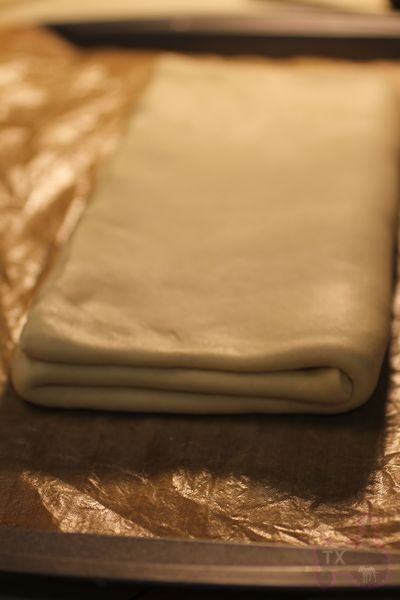
6. Put in fridge and rest for 1 hour. Take out dough and repeat the rolling and folding 2 mroe times, which gives 3 folds in total.
7. Put in fridge and rest for at least 120min.Roll out to 8X16inch, 1/8inch thickness. You may need to rest the dough in fridge several times.
8a. For classic croissants: cut into 4 rectangles, each 8X4inch. Then cut each rectangle diagonally into 2 triangles. Trim edges, stretch lightly into skinny long triangles.
8b. For Bear claws, cut into 5X3inch rectangles.
9a. For classic croissants: roll up fairly tight, stretch out the tip with one hand when you roll the bottom with the other hand. Since they are smaller, you won't get as many layers as the standard ones
9b. For bear claws, put a TBSP of almond filling on the dough, fold in half along the longer side. Seal, and make 4 cuts for the "claw" effect.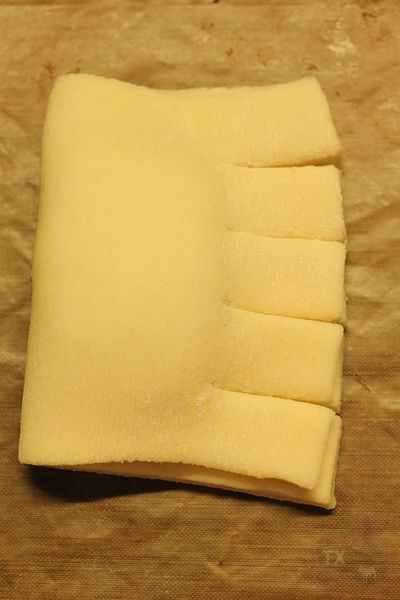
10. At this point, you can proof right away, fridge overnight and proof next day, or freeze (defrost overnight in fridge before proofing). Brush with egg wash (1 egg beaten with 1 TBSP of water), then proof @ about 80F until very soft and jiggly. About 3.5 hours for me. Brush another layer of egg wash after proofing.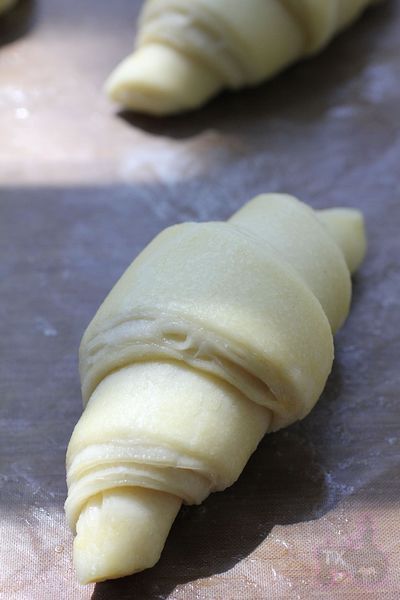
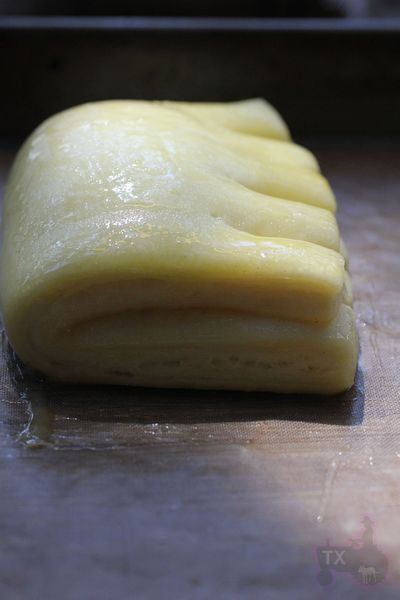
12. Bake at 425F for 10min, 375 for 15min.
The very round cross section indicates enough dough strength. The crumb is open with a clear honeycomb effect. 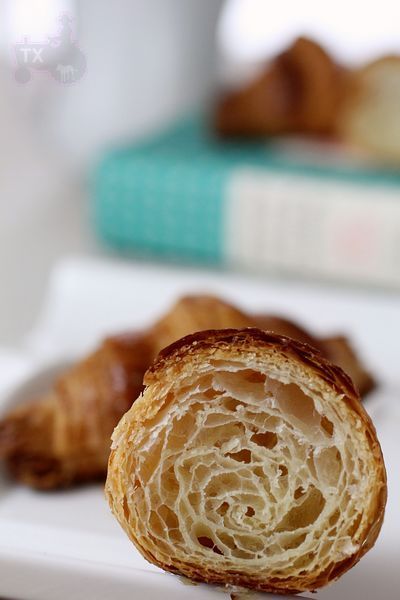
I am fairly happy with the crumb, but there's always room for improvement. The smaller rolls has less layers than standard ones, which means the crumb has less "holes".
The bear claws came out pretty well, with or without powder sugar. And I used the leftover dough from bear claws for some mini chocolate croissants.

Bear claws and chocolate croissants were rolled up in less turns than croissants during shaping, so the layers are very clear and very flaky - easier to make than the standard ones IMO.
With some major overhaul, this recipe produces very good results. 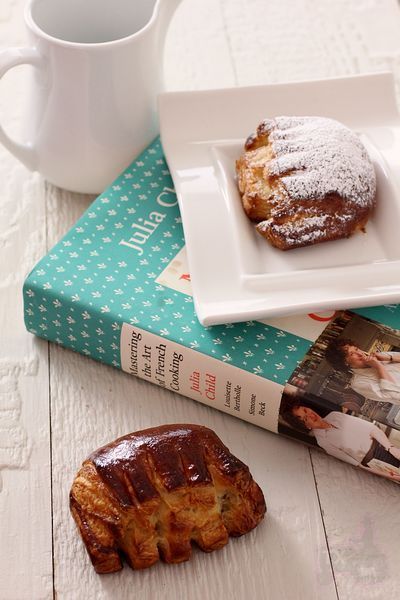
- txfarmer's Blog
- Log in or register to post comments
Great write up and photos, on your method for making more Gorgeous Croissants! Thanks for all your hard, cool work and sharing : )
Sylvia
Thanks Sylvia! It's fun to be able to share my experience.
Great write up and pictures and I'm stuck on step 4. I need one more picture. I imagine the dough corners get folded over the butter and meet or overlap in an "X" before getting rolled out. Please correct me if I'm wrong. Any special tips to sealing? Step 5. "Don't forget to trim the edges." Do I cut something off? Yes, I cut the edges (caught that on the other thread) I was worried about those rolled edges with less butter. You make it look so easy! I just got to try this! Can you tell I'm nervous?
Mini
1) Yes you fold over the corners to meet in the middle like an "X". No special tips on sealing, just pinch them together
2) Yes, trim off the edge to expose butter layer before folding that edge into the crease. Triming also makes sure that the butter layers get to all the edges and corners.
Don't be neverse, and don't be discouraged if you don't get everything perfect the first time -- for the first few times. I have been working on it for almost 6 months, still lots to improve!
of your caliber standard English words don't seem sufficient. So your croissants look scrumdidlyumptious ! Furthermore, your directions are so detailed and clear that if one day I start wandering down this path, I'll know where to start. -Varda
Thanks Varda for the encouraging words!
I never thought the size of the croissants matter, but it did. Likewise, I noticed that when I cut the croissants smaller, there weren't so much air holes inside. One time, I made the croissants larger. The isosceles triangle was something like 5" base with 9" height. I proofed them between 80 and 84 F until they really get huge and puffy. They really expand with large pockets of air inside. Also, I noticed the texture was lighter and flakier with the larger croissants.
Actually rather than size alone, I think what's matter is the "size/thickness" ratio. As we generally roll the dough out to be 1/8 to 1/4 inch thick, it's just right for a standard size croissant - rolled up enought times to create an open yet layered crumb. However, if we use the same dough to make small croissants, each layer of dough is too thick for the size, which means the dough won't be rolled up as many times, the crumb won't be as layered. I bet if we can roll out the dough proportionally thinner, mini croissants can also have good crumb. However, it's difficult to roll the dough out to much thinner than 1/8inch...
YOur always amazing and inspiring.....I finally got a decent croissant made and am taking a course, which I should of nixed since reading all your posts! Cheers and happy baking!
Jeremy
www.stirthepots.com
Absolutely awesome! I have croissants as a project for this Fall, but I'm so scared to go ahead and try them again... I don't think I am 'croissant material', but with your detailed instructions, I might just give it another try
Thanks for your work - very impressive and I am both not surprised and also in awe of you working on this over 6 months. I've also been a little confused by many of the different recipies - some say use cake flour, some say use bread, some say kneed only to combine and some say kneed 15 minute, bulk rise or no bulk rise ...
I've tried croissants a dozen times now and I keep running into the same problem, for the last roll, the butter is being exposed.
So, for the final roll out before cutting the trianges, do you take the dough straight from the fridge or do you let it warm up a little?
Also - why 120g milk and 14g water? Any reason not to just use 134g milk?
Thanks for your work - very impressive and I am both not surprised and also in awe of you working on this over 6 months. I've also been a little confused by many of the different recipies - some say use cake flour, some say use bread, some say kneed only to combine and some say kneed 15 minute, bulk rise or no bulk rise ...
I've tried croissants a dozen times now and I keep running into the same problem, for the last roll, the butter is being exposed.
So, for the final roll out before cutting the trianges, do you take the dough straight from the fridge or do you let it warm up a little?
Also - why 120g milk and 14g water? Any reason not to just use 134g milk?
Straight from fridge. Never let the dough "warm up". "Warm" is the enemy to croissant making, nothing good can come from warm butter, EXCEPT FOR after shaping,during proofing. Even then, it's the best not to go above 85F for proofing.
If butter leaks and the dough tears, either you have not relaxed the dough enough, or the dough is not extensible enough.
Milk has less water than pure water, so if you use all milk, you will need more.
folle! (=This is completely stupid and foolish thinking.)
I find this a rather one sided debate especially since the party filled with hubris and self congratulatory praise hasn't provided one shred of visual evidence supporting his claim to the "best croissants ever etc blah blah." Surprising for someone who has "produced hundreds of laminated doughs" and not one single pictorial frame of any work produced? Do you not have access to a mobile phone, digital camera or laptop to take one picture? Interesting indeed, talk is always cheap.
Txfarmer - I cannot for one single moment understand why you are phased by your crumb structure - it is absolutely perfect and would fill many a French patissier / boulanger with pride. Airy, honeycomb structure that is ideal and the proportion of thread lines to space is 100%. Whatever you did was spot on!
Now, the matter of dry dough. You're right - it is a delicate balance - but in France we NEVER tried to achieve a high hydration rate (or a wet dough as it has been termed.) This would have been disasterous. Proofing for one would have been more difficult. Secondly, high hydration croissant dough would definitely wrap itself around the steel roller of the laminator or dough sheeter. (Not a pleasant task to clean up - literally - at 2 in the morning.) Thirdly, please explain why in France we used the driest butter available - with the lowest possible water content? No, wet dough is total non-non.
Now to technique - since I haven't seen visual representation of fishguy83's "magnificent work" I cannot comment specifically but generally, there is much technique involved in croissant making. from the mixing to the laminating - (and yes, in France we also trimmed the dough to prevent leaks) to the final roll out and proof. It requires developed skills and practise and is not simply a walk in the park as implied - that's if you're producing it correctly. But I haven't seen the visual proof.
And finally, to the "volume-weight" debate. No self respecting French boulanger would even consider producing croissants (or any other type of viennnoiserie for that matter) without first weighing every ingredient - right down to weighing the egg yolk for the coating colouring in the bake. (la doree) I cannot comprehend why one would try to replicate a French pastry such as a croissant and then fly in the face of accepted practise (as carried out in EVERY patisserie in France) by adopting a guessing game by using "cups 'n spoons."
Snuff said!!
(For the record - I trained as a professional pastry chef / baker in France for 4 years, worked in two Michelin restaurants in Lyon and Nice and worked in one of the top boulangeries (bakeries) in the south of France. I have personally produced over 10 000 croissants in my time, all rolled by hand, as they should be. I trained in pastry at the Cordon Bleu school in Paris and at the International Culinary Academy in Cap d'Agde. Furthermore, I trained under, and was mentored by, the ex-pastry chef of the then 3* Michelin Four Seasons George V Hotel in Paris. I understand that this site, TFL, is mainly amateur driven however as a professional I am enthused by the swell and surge of home bakers around the world all basically striving to produce, bake, discuss and experiment with artisanal and other types of breads and pastries getting back to what bread should REALLY taste like.)
Very much appreciate your contribution PaulZ. Spoken like a "real frenchman" ;)
I tried this recipe today (well, last night and baked them today). The only change is I did it with a poolish and used coconut oil instead of the usual oil, and unrefined sugar instead of the white sugar. Turned out pretty well compared to previous attempts of mine, I can't quite roll them out as accurate as you seem to be able to, they always break and butter starts leaking. Anyway, here's the picture.
| ------------------------------
--------------------------------------| New comment:
| Author: fishguy83
| Title: there it is
Boy, I thought I was fed up with TX. Hardly. She at least means well. You,
however, make about as much since as a Mitt Romney commercial. BTW everyone,
I don't give a fig if I don't post pix. You can either believe me or not. I
don't care.It's not like you can taste my croissants through a picture
anyway.
You, like Tx, are making this seem hard. Maybe it has to do with the fact
I've laminated so many doughs, but people, PLEASE, this is not a hard
technique-even when you do it by hand. I'm so sick and tired of hearing you
and Tx ramble on about how hard this is. Get over it. BTW Mr Cordon Bleu, if
you were such a grand pro baker, then you would know this is easy, even with
a rolling pin. If I've done this thousands of time over and think it's easy,
and yet you've done it thousands of times and think it's dificult? Maybe
somebody should go back to school. THIS IS NOT HARD. THIS IS NOT HARD. THIS
IS NOT HARD. THIS IS NOT HARD. HOW MANY TIME DO I HAVE TO SAY IT'S NOT
HARD!!!!!!!!!!!!!!!!!!!!!!!
If you have any baking skills, you should be able to make good if not great
croissants your first time. Stop believing that this is overly hard or
requires great skill. The one thing I've learned, since making these by hand
without a sheeter, is that they're actually more tough than you would think.
The last time I made croissants, the butter block was competely solid and
didn't want to spread out. I should have rested the dough until the butter
slightly warmed, but I said screw it. I was in a hurry. So, I just rolled
them out anyway. After the whole process, I was convinced something wouldn't
turn out. But, in the end, they were perfect just like the rest.
By the way genius, did I ever say you need to use a wet dough? I don't think
so. You might want to learn English, too. Never, ever, ever did I see to use
a wet dough. To get an idea of what kind of dough (texture/water content)
that I like, here's a YouTube from someone who actually knows what they are
doing. http://www.youtube.com/watch?v=hhpxkGB1OyY [1] This guy is serious
baker. Does the dough at 00:35 look anything like a dry dough? Hardly.
I just encourage people to make a dough that isn't overly dry because, as
novices and as people who haven't laminated hundreds maybe thousands of puff
pastries like me, they are possibly setting themselves up for a disaster.
Also, when it comes to making hundreds of croissants, I would probably use my
scale to measure. When you're making small batches, metric weights are a bit
time consuming and unneeded in my opinion. I live in a part of the world that
can be both humid and arid, depending on the season. This humidity can cause
market differences in, specificall,y the liquid needed.
So, when making small batches, I get a little flustered with people who have
both exact dry and wet metric ingredient lists. I know full well that I have
to add more or less liquid depending if it's winter or summer.
Also, perhaps you're not aware of this foreigner, but in America our butter
has slightly less fat and slightly more water. So, to account for the extra
water in the butter, it's advantageous to, unless you can find isigny ste
mere butter or some other French imported butte, to add a bit of flour into
the butter block.
Lastly everyone, I don't consider anything I do great until other people tell
me. If anything, I hedge until I think otherwise. I'm a scientist by trade. I
don't make hyperbolic statements normally. Everyone I've fed these to agrees
that they are, hands down, the best in Minneapolis.
Bottom Line: Tx and Paul, you make everything seem too hard, and your
comments only make people either less likely to make the product or mess it
up in the process. Regardless other readers, pay close attention to these
people. Also, look at the YouTube vid. It really says more than anything
these two jokers have to say.
@FishGuy1883
Scientist eh? What's science? Science is two things at it's core. Firstly it's about the testable hypothesis. That means theory (what you propose and say) can be tested (resulting in evidence). You've spoken at length about your hypothesis but where is your evidence? (Remember cold fusion?) Secondly, Scientific theory is about peer review. That means that your theory must be able to be examined by your peers (that's us) and we should be able to perform your experiments and get the same results.
If your parents didn't teach you to be polite then I'm sorry. But in their place, I suggest you calm down, read the writing on the wall and back away from your insulting and rediculous posting.
/Stuart
Dear fishguy83
I shall not stoop as low as you have done in your posting and I shall not dignify your response in the same childish and acrimonious manner in which you have written about TXFarmer and myself.
I find your writing lacking in credibility (I don't believe you have rolled a croissant in your life hence the lack of pictorial evidence) and you seem to gain perverse pleasure in writing provocative statements regarding baking. When you have produced the volume of work that TXFarmer and I have, then maybe, just maybe, you'll have reason to bleep. In the meantime, climb under your rock in Minneapolis (talk about a big fish in a small pond syndrome) and enjoy your small town self-imposed celebrity status and continue making your non-existant croissants.
Please desist from lowering the currently high standard of comment prevalent on this very valuable site. No-one is really interested in your over-inflated ego and your clear lack of skills or even the dearth of basic knowledge of laminated doughs.
PaulZ.
PS: Despite your insulting comments, I have studied English and qualified as an English language teacher in 1976. I would sincerely suggest that you read through your own copy before posting on this site since every posting of yours is riddled with spelling mistakes and blatant grammatical errors. But then, I didn't really expect much more from you.
Wow, these look perfect. I'll have to give these a whirl. I make laminated danish pastry dough and the drier the dough, the better the flake and separation. That's why I'd want a dough sheeter! It's tough to laminate a dry dough by hand and rolling pin.
Those croissants look so good. For more crispyness, use water instead of milk. I watched Vincent's video on making croissants; he uses water, yeast, sugar, and flour. Water makes the pastry crispier.
Good tip, lazybaker.
Hi txfarmer, did you make a couple of incisions/cuts at the wide end before rolling?
I made croissants today, well, started in the wee hours of this morning; 1 a.m. and let the dough and butter refridgerate over night. One batch was almost perfect, while the other had a lot of butter bleeding. Suddenly, I realized I'd over done it. The dough had the 2 hour original rest w/butter, then there was a 2nd folding w/1 hour rest, a 3rd that followed and then I had a final 4th resting. Perhaps I heard the 4th from another croissant program, I'm not sure. During the 4th folding, I remembered I needed to do a wallet. Well, I'd already rolled it out into 3rds, now I'm rolling it out in the same setting again for the wallet. When the time came to roll the dough to form croissants, I wondered if it would rise? Have I killed the yeast? The texture was no longer as it was before. I rolled and formed the croissants but am curious if anyone else has made this mistake and still had success? These are for Thanksgiving so I've placed the croissants on a lightly floured cookie sheet, separated and covered into the freezer. I suppose I could bake one and have my answer before the time comes. Making yet another batch of this scrumptious treat would be nothing more than delightful!
btw, what a beautiful blog! I've always used Esther McManus' recipe, baking w/Juilia Child, as I'm just not liking the oil in Julia's original and feel it's more French authentic without. http://video.pbs.org/video/2250835454/
Although I did watch Julia Child hand mixing/kneading here in her origianl program since my mixer is out of service. http://www.youtube.com/watch?v=YU1HBpFIGKs&feature=relmfu
I couldn't do this w/out watching these videos over and over again and still I made a possibly terrible error...now to take out a croissant from the freezer, place it in the fridge and bake it for breakfast to know for sure what I've done...and happily make another batch before Thanksgiving!
I've had success with three bookfolds. The bookfold (or wallet) creates four layers when you fold, so if you do it three times, then you have 64 layers ( 4 x 4 x 4). I get nice flaky layers that aren't too thick or too thin. Too many folds lead to very thin layers that might end up fusing together and won't produce flaky layers. Too few folds lead to thick crunchy layers.
The yeast is dormant if you keep the dough refrigerated. When you proof, you need to make sure the room temperature is around 75 to 78 degrees F.
I couldn't do this w/out watching these videos over and over again and still I made a possibly terrible error...now to take out a croissant from the freezer, place it in the fridge and bake it for breakfast to know for sure what I've done...and happily make another batch before Thanksgiving!
I would just set them on the counter to thaw and proof until they're puffy before baking. I think putting them in the fridge after taking them out from the freezer will make them too cold, and you might end up with butter melting and pooling when you bake them. You want to get the butter up to room temperature and the dough well proofed before baking, so butter won't melt so badly during the bake.
Good luck.
thank you lazybaker, I totally agree...my concern about killing the yeast is due to not letting the dough rest between the 4th & 5th rolling & folding into the wallet. Before rolling to form, the dough didn't proof nearly as much as the other batch which is leading me to believe I may have released the gas of the yeast and killed it. I still have an hour and 15 min to wait and see if the dough will proof. I pulled one from each batch from the freezer before bed & let them thaw overnight in the fridge, then transferred to an oven around 7 a.m. but I'm not liking what I'm seeing. This is a good experiement before the big day. Failure is an opportunity to grow, but I dislike it happening during the presentation! :)
I also used a fresh yeast that expired an hour earlier. I know, sounds funny but it's my 1st time using fresh yeast and I only had a couple of days before it expired, which was barely enough time for me to use it. The doughs appeared to be doing great, which I know they lose potency the closer to expiration.
If these do not turn out well, I will definately purchase fresher yeast, make the dough, perhaps freeze before forming, thaw Thanksgiving eve morning, form croissants to proof in the fridge during the night & then bake Thanksgiving day, although, I do believe they should be just fine formed, frozen until ready to use, proofing before baking.
I baked my croissants and learned another lesson.
1. even at a high altitude, don't turn the oven down 20 degrees to compensate the convection oven. The croissant I was most concerned about was delicious but super flaky outside and a little on the under done side in some parts inside. It couldn't be baked any longer w/out burning the outside. I think the temp of the oven was the cause of this problem, that or the double rolling and folding without rest maybe.
So I will make another batch or two this week, as I'm pleased enough with the results.
I'm definately for the forming and freezing croissant. Also, I'm going to get some fresher yeast or use an instant to see if they'll rise like they did last year. Not sure why they were so flakey on the outside. I've never had an issue with pooling butter.
OMG !! These look perfect!! I love your conscientious persuit of the perfect croissant it makes me feel less concerned about my search for big holes in my Sourdough. Right after I get holes I am going to try out your method. I had given up ever having the heavenly croissants I had in France in the states--Trust me Costco's come from the underworld. Yours look beautiful. Pambakesbread
Interesting thoughts about whether butter bleading meant the dough is perfect or not. According to Esther, in the video i posted, it's completely normal, not a failure. Temperature, climate, yeast and butter moisture have so much to do with the puffiness of the croissant.
Questions: are big holes inside the baked croissant good or bad? What's your goal? Lots of little holes or big holes? And it's good to have flakey crust? i guess i've got the touch.
Those learning would enjoy watching Esther make them and follow along. It's fun and so rewarding. Croissants are very giving :)
I've tried following this recipe twice.
The taste is fairly good, however I've had some problems with rolling out the dough; specifically, butter leaking out of the dough when rolling it, as well as the dough tearing (bottom layer) during the last roll out before I shape the croissants.
Below is the final product. Any suggestions on rolling out the dough?